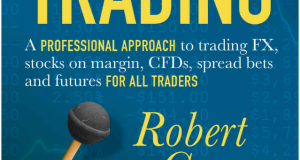 I’m a member of the Market Technicians Association (MTA) and a holder of their Chartered Market Technician (CMT) certification. But not for long. I had a good reason for joining and I have an even better reason for leaving. What I actually lack a good explanation for is why I remained a member for so long time.
I’m a member of the Market Technicians Association (MTA) and a holder of their Chartered Market Technician (CMT) certification. But not for long. I had a good reason for joining and I have an even better reason for leaving. What I actually lack a good explanation for is why I remained a member for so long time.
The MTA is the largest and most well known technical analysis organization. They are primarily based in NYC, but have chapters in cities all over the world that meet regularly. They also have the CMT certification program, what they would like to market as the technical analysis equivalent of the CFA.
I joined the MTA a long time ago. At that time, I was relatively new in a for me unknown country where I lacked industry contacts. My plan was to join the MTA and do the CMT certification to get to know the local financial community. It was, as much as I despise the term, a networking effort. As such it actually paid off. By pure luck, I ran into someone through the MTA that I ended up staring a business with. The fact that he later later stole a large sum of money from me, hid behind his shady Panamanian shell company and threatened to sue me if I ever speak of his theft is of course a completely unrelated story. These things happen.
When I was reading the books for the CMT exams, I started getting a little worried about what I was associating myself with. I had expected that an organization like the MTA would take some sort of responsibility for content, encourage research and critical thinking. Well, not so much. It’s more about reading some rather far out mysticism books and parroting the content back.
On the book list, you’ll find some classic old TA books, some that are written by people who are friends with the education committee, and some that are just ridiculous new age nonsense that doesn’t stand up to any sort of critical review.
Before you sign up for the CMT program, consider the type of questions you’d have to answer. Take a look at the sample questions here to get a feel for what kind of skills are required.
In a normal 5-wave Elliott upward motive impulse wave, which wave is most likely the longest and most dynamic?
a. First
b. Fifth
c. Third
Elliot wave, for those lucky enough not to be familiar with this concept, is a religion based on the belief that everything in the universe moves in a predictable wave pattern of five waves divided into three sub waves. Totally relevant for a finance professional. Bringing up this subject in a real job interview for a serious finance job is on par with discussing your theory about the chemtrails that the CIA are spraying to make us all forget about how they demolished the twin towers.
Which of the following is a Fibonacci ratio used in retracement?
a. 33%
b. 50%
c. 66%
d. 75%
Yes, I guess we can’t have magical waves without magical ratios. Fibonacci numbers are for the mathematically impaired and for highly impressionable people with limited ability of critical thinking. This particular question is even more odd, since none of them would strictly speaking be true. Yeah, they’re looking for 50%, but that’s only a Fibonacci ratio if you really, really stretch the already wafer thin concept. The series starts 1, 1, 2, 3, 5, 7, 13… When you the numbers increase a bit, you start getting a more stable ratio, should you for some reason divide consecutive numbers. As with most such series, the lower the numbers are, the higher the variation and if there was any sort of predictive value in this approach, which there isn’t, shouldn’t the reliability come in after the numbers grow? I mean, dividing 1 by 2 and calling it a Fibonacci ratio? Well, since all the other ratios are nonsense numerology anyhow, I guess it really doesn’t matter.
There’s not just the obvious Fibonacci and Elliot scams they ask about, but they even touch a bit on my own field:
Trends are more likely to persist than reverse in
a. no markets.
b. all markets.
c. bull markets only.
d. bear markets only.
I would have failed this one. I would argue for C until the devil comes for me. Yes, you can use trend following on the short side but that’s bloody tough and gives you very low success probabilities. The short side helps your return skew, but to stay that trends are more likely to persist than reverse in bear markets is stretching it.
Regarding trends, which of the following statements is NOT correct?
a. Always trade with the trend.
b. A trendline break is at least a warning of a changing trend.
c. Breakouts from support/resistance are usually a change in trend.
d. The longer the trend, the more difficult it is to identify its reversal.
Another one in my own field that I would have failed. Certainly one is a very dangerous statement, when expressed as an absolute. Trend lines are highly subjective and cannot be properly tested, so who knows. Breakouts would very much depend on what direction it breaks out in, relative to previous price direction, so perhaps they mean that. As it turns out, they’re looking for the last answer, which I ‘m really sure what they mean by.
Let’s have a few more funny ones:
The Kondratieff Wave extends for a period of approximately
a. 13 years.
b. 54 years.
c. 13 weeks.
d. 54 weeks.
Which of the following is NOT a valid trading rule using Elliott Wave Theory?
a. Identify a main trend
b. Determine the current status of the main trend by locating the major peaks and bottoms
c. Look for five wave corrections and three wave sub-trends or extensions
d. Draw trendlines to determine direction
Which of the following is true of W.D. Gann’s trading techniques?
a. His work is valid for equities but does not apply to commodities
b. When price meets time, a change is imminent
c. Gann used 10%, 20%, 30% and 40% as his key resistance and retracement levels
d. Gann’s work is an advanced interpretation of point and figure charts
Which of the following is a true statement according to Elliott Wave Theory?
a. A complete bull market cycle is made up of eight waves, three waves up followed by five waves down
b. A trend divides into three waves in the direction of the next longer trend
c. Corrections always take place in five wave patterns
d. The two types of simple corrections are zigzags and flats
Which of the following is a true statement according to Elliott Wave Theory?
a. Triangles are usually second waves preceding a longer third wave
b. Waves can be expanded into longer waves and subdivided into shorter waves
c. In the stock market, wave 5 is the most common to extend
d. The Pythagorean theorem is the mathematical basis for Elliott Wave Theory
Which of the following is a true statement according to Elliott Wave Theory?
a. Wave four should not overlap wave one
b. The theory is composed of time, ratios and wave forms, in that order of importance
c. The theory was originally applied to individual stocks and does not work as well for indices
d. The theory works best in commodity markets traded primarily by professional traders such agricultural futures
Which of the following is NOT a basic principle of cycles?
a. Summation
b. Synchronicity
c. Harmonicity
d. Alternation
Which of the following places the cycles in time length order?
a. Lunar, presidential, seasonal, alpha/beta and Kondratieff
b. Kondratieff, presidential, alpha/beta, seasonal and lunar
c. Alpha/beta, presidential, seasonal, lunar, and Kondratieff
d. Alpha/beta, lunar, seasonal, presidential and Kondratieff
Which of the following is a CORRECT inter-market relationship
a. Bond prices move inversely to equities
b. Bonds prices trend in the same direction as commodities
c. The U.S. dollar moves inversely to commodities
d. Financial stocks trend inversely to bonds
Which of the following is a CORRECT interpretation of the shooting star pattern?
a. It is even more bearish than the gravestone doji candle
b. Shooting stars in charts, as in life, are omens of good fortune
c. The color of the real body is of utmost importance to its significance
d. It is a bearish reversal pattern
Which is NOT true of the three advancing white soldiers’ pattern?
a. It is a gradual and steady rise
b. Each real body opens within or near the prior session’s real body
c. It is composed of three white candles with successively higher closes
d. Each candle should have a long upper shadow
Well, I think you get the picture. It gets worse from there. Including charts where you have to give your analysis based on magical waves and numbers and predict future direction.
To receive the CMT title, you need to pass three exams of the style shown above. That is, repeat without questioning what’s in the book no matter how absurd. You need to pay too of course. Every year. Not just while doing the exam. You have to keep paying, every year for the rest of your live. Else they’ll take the CMT title away. Oddly, my old university never threatened to take away my master’s degree if I didn’t pay them a yearly kickback.
The fees?
$250 for registration to the CMT program.
$250 for doing the first CMT level exam.
$450 for doing the second level exam.
$450 for doing the third level exam.
$300 every year for the rest of your career.
If you do the whole thing in three years, it will only set you back about 2k. And if you remain a member the rest of your career, it’s just another 12k or so, not to lose the title.
The larger problem is reputation. Do you want to be associated with these get-rich-quick schemes targeted at neophyte retail traders? Putting CMT after your name these days makes people worry. Oh no, not another obsessed numerologist again…
As I wrote about before, it’s not that the underlying ideas of TA are stupid. It’s just that it’s become a bloated subject full of everything from moon cycles to magical waves. It’s also attracted such a massive amount of people with little to no knowledge or desire to learn, who sees TA as a get-rich-quick scheme. They’re just ripe marks for the thriving market of TA scam artists out there, pushing books, courses, mentoring, coaching etc.
If the MTA wanted to be taken seriously, they should have addressed this a long time ago. The key skill to learn in the TA field is critical thinking. Most is BS and you need to learn how to identify it. How to apply critical thinking and properly test methods before taking them at face value.
But that wouldn’t get as high membership count.
Dear MTA, Thank you for these years and I wish you best of luck. But I won’t be renewing my membership.
So long and thanks for all the fish!
 Following the Trend
Following the Trend







Yeah, I already noticed that I got the Fibonacci sequence wrong. But why change it? It’s not like it would make anything more accurate, would it now… A random number generator or a good old fashion monkey flinging feces at a chart would work just as well.
Being led into battle by crappy methodologies without robustness is a waste of money. One cannot accurately say, however, that there are no TA methodologies that are profitable. One needs to know where to look. Its not the most obvious answer, its usually the easiest. Most will fail, but others who can follow a robust approach and learn it, as well as having money management, will make money. Tying new traders to get rich quick schemes is good, but they need to do that to become a seasoned trader. We all go through it. In the spirit of open forum, I would be in error to not mention Hurst cycles as a means of learning how to trade.
Some have claimed that 50% of reversal are within 1 point of a fib number. So when you say it went to a fib number and reversed you are not really saying much.
I took that same decisión long time ago and based on the same if not very similar reasons.
Except for a few minor points, I have to fully agree with you. After much hesitation I renewed my membership again for a year for the sole reason that clients somehow look for it – without actually knowing or caring what CMT stands for. MTA makes use of a human weakness: once you have something people think it worth something, you are not going to diminish your ‘added value’ afterwards.
Hi Andreas,
I must say that I also hesitated to become a CMT or CTA. I 100% agree with you! Such exams are bullshit! When I saw the questions a few months ago, I decided not to become a CMT or CTA.
However, it’s impossible to be a money manager if you don’t have any of these certificates. I tried to open a managed account for money managers at Dukascopy Bank SA in Geneva and they wanted I had such crap exams. Hence, I decided to trade proprietary funds only.
That sounds odd to me, Pavel. I’ve never encountered a situation where it was an advantage to have a CMT title. The banks certainly wouldn’t care. Of course, if you want to manage an account for others here among the Alps, you’d need to be a member of an SRO, but they don’t care if you’ve got a CMT, CFA, FRM or other TLA.
The primary reason to get these certifications is if you’re young, lack experience and need to fill out your CV. The funny part is that any masters of finance or equivalent from an actual university is worth much more than a CFA, but no one would put that after their name.
Also, in all my years in this country I’ve never heard of a Dukascopy Bank. Go to a normal bank and you’re fine. They’re discussing increasing regulations here, but so far you’d only need SRO membership to manage individual accounts. For collective schemes the situation is a bit more tricky of course.
CTA is a regulatory status from the NFA, which is pointless if you’re based in Europe and have your clients here. In practice, the term CTA tends to be used for any futures manager around the world, regardless of whether they have that actual title from the NFA or not. I once had to clear up that little misunderstanding when I was deposed as an expert witness in a US court… Long story…
Andreas, I thank you for your reply! I actually live in the Czech Republic, but I want to use Dukascopy Bank SA as my broker, however, they want some paper that I am capable of managing money for other people. I studied finance at my Business Academy in Prague so I have enough knowledge of markets. Where could I find more information about SRO?
Thank you!
PK
If you’re not based in Switzerland, our SRO system is not relevant to you. Anyhow, I can’t go into specific regulatory advise as that would be highly inappropriate.
Managing other people’s money is getting more and more complex from a regulatory point of view. You need to look into what regulations apply to you in your jurisdiction and what type of licence you would be required to obtain. This can vary quite a bit from country to country. One thing is for sure. Don’t mess with regulators. Follow the rules or you risk being unable to ever work in this business again.
Be aware that in most countries it can be very expensive to become a licensed asset manager.
Andreas: Thank you for our description of some of the CMT Questions. I am a member of the MTA basically lfor the chance to socialize with some of the old timers. Looks like there is a lot of garbage in those tests. I am currently tranked No1 by Timers Digest and I do not have a CMT designation. I am a market timer and I have been using my mathematical formula to time the market for over 40 years. No predicting, no guessing, and no BS. My last two Signals were issued Buy Signal on 2-12-14 and Sell Signal on 7-31-14. If you would like to see a copy of my latest Newsletter, just ask.
jim rohrbach,RIA
jrohrbach@investment-models.com
Thank you for making my point, Jim. I removed the link to your site as the first thing that I saw when clicking was the usual malware popups with warnings about my browser being in urgent need of updating. No thanks.
If you have the time for a laugh, you might want to look at this one instead (without the malware, but highly amusing nontheless):
http://www.cxoadvisory.com/21776/individual-gurus/jim-rohrbachs-disagreement-with-review-of-his-technical-timing-approach/
I know I should be surprised.. but for some reason I’m not.
Thanks for putting up these questions, it’s good to see what they actually ask on the technician tests.
I thought about taking one a long time ago. My thinking was that I could put it on my CV and might meet some interesting folk. But I was always quite skeptical and I’m glad I saved my money.
Another great article Andreas.
I’d like to second what you’ve said regarding the lack of interest that employers have in the CMT. I can only speak from personal experience but my first prop trading job interview involved a 20 minute maths test. Candidates had to get 90% correct in 10 minutes. I then had to answer the following question…”how many street lights are there in the U.K?”
The irony is that my employer wanted rational, logical and mathematically inclined people to work with, whereas an in-depth knowledge of Fibonacci sequence clusters and wave patterns would suggest quite the opposite of a candidate!
How sad then that so many people with a newfound interest in trading think that reading Bob Prechter will provide more value than reading Karl Pearson.
Very entertaining and informative post (as usual). I dropped my CFP designation after many years, as I realized the educational arm of CFP was purchased by the same company that owns University of Phoenix, Apollo Education Group. (APOL). Annual dues doubled recently…but why? To advertise for more students for APOL? or to advertise the designation to the public? I dunno but I believe it is all very dubious and not about furthering the professionalism of financial planners, but to rake in more fees for apollo. – Too many of these companies get to use 503(c) “not for profit” tax benefits for money-making ventures!
Companies owning universities? Hm.. What could possibly go wrong with that?
There are always irrelevant questions or subject matter for an exam, designation or degree. I know plenty of people who would argue that the MBA holds no relevancy vs “real” world experience. I had a non-degreed, bank executive tell me this, at the same time he was paying for his daughter’s graduate college education? You obtain the designation, then you use that designation to get into a position where as you can prove to others that you are capable.
Great article Andreas. Could not agree more with your points and with the comments made by others here, too. The beginning of the end for the CMT program, was around 2002-2003, when they dropped the requirement for the CMT-3 research paper.
Hello Andreas,
In some of your twits you’ve asked if anybody has Liz Chaves’s presentation Let’s Get Negative. I saw it awhile back online and I have this link to an article discussing it among other interesting topics:
http://www.automated-trading-system.com/eighteenth-century-trend-following-and-more-history/
Unfortunately this beautiful and smart woman passed away at the age of 56 last year:
http://www.bloomberg.com/news/2013-03-18/elizabeth-cheval-emc-capital-chairman-dies-of-aneurysm-at-56.html
and the site quoted in the first link doesn’t exist anymore. The company EMC Capital of course is still there.
Thank you for your book and very pragmatic, yet strict articles.
Regards,
Victor Rivkin
Thank you, Victor. Yes, it was certainly said to see Liz pass away last year.
What I learnt recently is that EMC deliberately took that file offline for compliance reasons.
I did actually manage to get hold of a copy, but from a source I cannot name and only with a promise not to distribute it any further. I will abide those conditions and keep the file to myself.
Sure thing, Andreas. Glad you’ve got.
Victor
Hi Andreas,
Thank you for your article.
I was contemplating the idea of joining the MTA b/c I really like Carr’s book “Smart Investing…”. Carr is apparently the editor of MTA “Technically Speaking”, I enjoy reading some of their articles I must admit.
Then I came across that: https://w3.newsmax.com/Offers/Finance/PKP/Symposium-Order
That was it for me, they lost me right there!
Cheers,
FL
It always amazes me that there are actually people out there who see a page like that, and then decides to give them money. A page like that should set of a klaxon bell and a big blinking FRAUD sign in front of your eyes. And then some people actually go and give them a few thousand bucks.
I took another look, Francois. There’s also this interesting video, where the super genius who was apparently singlehandedly responsible for winning the cold war explains how his magical trading system will compound at over 50%, and probably much more. => https://w3.newsmax.com/LP/Finance/PKP/Symposium-Video1-EXT?promo_code=otrynrb3
How can anyone see something like this and not see the obvious fraud? (Yeah, go ahead and sue me, asshole. I dare you.)
These people are not in finance. There’re in the con artist business.
Thx Andreas, very interesting indeed, I love these infomercial where they always say “but wait, there is more”!
Truth is it’s bad publicity for the MTA and finance in general.
On a different note, have you read “Profitable Momentum Trading Strategies for Individual Investors”? http://papers.ssrn.com/sol3/papers.cfm?abstract_id=2420743
I didn’t, but I’ll take a look. Thanks, Francois.
Hi Andreas,
We just discussed dollar pull-back implication on correlations with different assets on the other site, so you kinda know where from I am 🙂
I just wanted to mention that your statement “Fibonacci numbers are for the mathematically impaired and for highly impressionable people with limited ability of critical thinking” is not right with respect to analysis of complex systems, at least in general.
It’s fairly recent remarkable development in mathematical physics, which showed that, in particular, appearance of amazing flowers shapes and cacti is related to nonlinear partial differential equations, and is basically is the consequence of the fact that product of 2 cosine functions will lead to appearanceof cosine of double argument.
As it is accepted in scientific society, I can provide you with the references to the publications in peer reviewed journals. And the authors are highly reputable professionals.
Now the question — how relevant is it to the markets? I don’t have the explanation. Only arguments like the market is the dynamical nonlinear system with external forcing, very complex one.
Another evidence is that the price behavior often reacts to Fib numbers, which can be of course argued as “self-fulfillment prophecy”. It might be. It might be not.
I should qualify that statement: Using Fibonacci numbers for financial analysis and forecasting is for the mathematically impaired.
There are clearly useful applications of Pi too, but using it for drawing lines at 3.14% retracement on a chart would clearly be insane. Very few people would come with such an idea. Besides, how could anyone trust an irrational number?
I’d say that we have a similar situation for Phi. If anyone could show that 1.618 has a higher predictive value in the financial markets than 3.14, I’d love to see that. So far, no one has been able to show anything of the sort.
I’m also very skeptic about the whole self fulfilling prophecy argument. It’s a common argument that often comes up. “Perhaps some crazy methods work because so many people are using it.” Recently a technical analyst at an investment bank told me that he only looked at unadjusted futures charts, because so many others do it and therefore TA works on it.
In my view, that’s both insane and a clear misunderstanding of how the markets work. This is not a democracy. It’s not one person, one vote. It’s one dollar, one vote. There could be two million crazy people out there trading their private accounts on new age numerology and even if they for some reason would actually interpret these complex rules the same way, and make the same decisions, it still wouldn’t matter. They’re tiny, even combined.
A single billion dollar hedge fund would outvote them all in a second. And then the multi billion dollar hedge funds outvote that fund. And everyone else who controls large amounts. A sub culture within the retail TA community isn’t going to move any prices anywhere.
Andreas, in fact I’m 99% agree with your article and 90% with you reply 🙂 . The _almost_ whole TA advisory industry is the scum artistry — I’ve been burned severely too …
Regarding Fib. There is small hope, though. Let me explain what I mean. Yes, large moves are caused by multi-billions hedge funds — that’s what I referred to “external forcing” in my previous post, that’s mathphysics lingvo. There could exist, however, some periods of time when the system lives by more or less “conservative” laws without such forcing, i.e. behaves according to some nonlinear partial differential equation, in “cacti-flowers” spirit I referred before. Those periods of time can exhibit those Fib properties, just like flowers and cacti do. That’s why it might happen that we don’s see those Fib numbers all the times. The whole point of my flowers and cacti example was that Fib numbers are, in fact, the footprints of nonlinearity in the system.
And the most depressive thing in your article was your partner treachery story. Mirror reflections. Humans are the same in different part of the world.
Here it is, the nice short introductory article with the references on Fibonacci numbers as a property of nonlinear partial differential equations:
http://thatsmaths.com/2014/06/05/sunflowers-and-fibonacci-models-of-efficiency/
Hi Andreas,
Great post, I felt the exact same way after reading a few example questions on the MTA website, safe to say I won’t be wasting my time or money on their BS. I’m currently studying for the CFA level 1 in tandem with my masters degree (primarily for the same reasons you took the MTA) and am sad to see that a few of these type of questions have wormed their way into the CFA curriculum. As I understand it the CFA institute didn’t include anything in the way of technical analysis, but after much protesting from a few practitioners they have since introduced a few questions on Kondratiev waves, Elliot wave cycles and some other bits of unscientific hoo-haa. It makes me sad that they took the easy route by picking a few of these ideas, presumably because they are easy to construct multiple choice questions around, instead of focusing on rigorously investigated time-series or cross-sectional return anomalies well documented in academic finance literature.
This is a great article. I rarely see such an honest point of view against a part of the trading ‘establishment’.
All I can say is LOL. Obvious why MTA cant be taken seriously anymore. Its a money grabbing establishment delivering certifications with NO value.
Hi Andreas,
the certificate of the “IFTA” (International Federation of Technical Analysts) offers a comparably useless experience. The books selected, at least some years ago, were a strange collection, even stuff like Gann lines where not excluded. The good thing: IFTA charges no fee once you completed the exam. The bad thing is that you cannot save any money by giving back your certificate. Still inexcusable that I did not have a time-based stopp loss back then.
Best regards
Nick
Hi,
Yeah, good point Andreas. I agree with you and the vast majority of posts here.
Although I have passed all 3 exams they didn´t give me the designation due to my lack of 5 year experience required or so. Nevertheless, I know exactly what you mean. I´m thinking of not renewing my membership neither.
Anyway, I saw they finally renewed their curicullum, starting past autumn administration (actually I kind of had to adapt myself to it as I took the last May 2015-administration exam, i.e. much more Risk Management than before).
This is the breakdown for level 3 currently:
Ethic and Standards= 5%,
Vollatility Analysis= 7%,
Behavioural Finance=10%,
Classic Methods= 21%,
Portfolio Management= 18%,
Asset Relationships= 18% and:
Risk Management=21%.
I wonder what exactly remained in the “Classic Methods”.
Yes, they were saying back then when I was studying for my last exam, that they would remove much of the BS( Elliot, Fib, P&F, etc.). Apparently they did. Did the MTA finally open their eyes ?
Still, definitely shouldn´t charge anual fees!
Regards,
Vasile
Interesting.
After I wrote this article, the president of the MTA contacted me and asked to have a beer and chat about it. He told me about plans to clean up the curriculum a bit, but frankly I didn’t believe him. Perhaps I was wrong.
I got an offer to be part of the process to improve the course, if I rejoin the organization and stop creating bad press for them. I declined the offer but said that I will stop picking on them and wait and see what improvements they’ll come up with. I also told him that as long as they have a prominent member of their ethics committee running very visible and very obvious retail trading systems scams on the internet, they will have a serious credibility problem. I don’t know if that person, whom I won’t name here, is still on their ethics committee or not though.
Hi Andreas,
That person, that ethics guy, I don´t think he´s still with them. And probably there is even a new president now, as I heard.
Anyway, as I said, it still annoys me that one has to pay annual fees. No university charges you for keeping the degree, as you rightly said.
Changing the subject for a minute, I have read your book, Stocks On The Move, and I liked it. I´m thinking of starting trading on my own money a little bit and for that I´ll need your help as I am a noobie on this. How can I contact you? I just want to give it a try ( I also have read here your other post about the need to enlarge the base fee but I don´t think I´ll ever be able to manage other people´s money due to high regulation and costs – I live in Europe. And other reasons too ( like inexperience, of course ).
On page 106-107 we see your stock selection. I know it is only for a demo standpoint and we would have to consider rescaling, portfolio and position rebalancing, rescaling, etc., but I just looked on how the stocks did in the next days or so, and I found out that the vast majority of the first 23 stocks reversed the uptrend right after were bought except for Kroger, EA and STZ, if I accurately remember. Which made me wonder: doesn´t this stock-selection model buy too late, at or very near the tops? I must be missing something, right? ( I have a good excuse: novice in this business).
I don´t know (yet) if this approach works or if you are a good manager( although you seem to be), but one thing is for sure: you are a HONEST person. You don´t try to fool anyone. And, in this industry, that´s quite uncommon and indubitably extraordinary ( no offense to your peers )!
Cheers,
Vasile
Ha! I guess it wasn’t too hard to figure out which ethics guy I was referring to. 🙂
You’re right, about Europe. 10 or even 5 years ago, things were so much easier here. Now we’re bogged down in expensive regulations, mostly designed by the larger players to make sure smaller players can’t compete. Not a great situation, but not much we can do but to comply. It’s very hard for anyone to run an asset management business in Europe these days with less than $100M.
The momentum model isn’t designed for optimal market timing. Those things almost always fail in reality anyhow. The model is designed as a robust way to ride momentum. You could try to change the rules to get stocks with very high momentum that just dropped back a bit, and see what you get. It’s not at all impossible to trade like that, just a bit more difficult. Make sure you get enough added value for that added complexity though.
And thanks for your kind words. It’s not like I’m some sort of Super Trader. I never claimed to be, and I never will. The difference between me and most trading book authors is much simpler than that. The difference is that I’m actually in the industry, with a real background in the business. All too often, trading book authors are just some bozos with no background, experience or knowledge of the subject, who made up highly improbable legends about their own achievements, so that they can sell books, systems and mentoring to unsuspecting hobby traders.
If you see someone making improbable claims, they are most likely lying. (hello guy who claims to train people to become trading millionaires for a fee)
Hi Andreas,
Thanks for your article. You had me in stitches with you pi comment… drawing circles on the chart… so true.
I am a self directed full time trader (scalp futures and swing stocks) and I was just poking around and ran across this CMT certification. I thought it might be fun given that I might teach this stuff in the future but after checking out what they teach, it is worthless. Actually, not worthless… it has a use. It tells you when all of the dummies will be buying your shares that you racked up a fat profit on.
Intense study of the price movement itself tells you everything you need to know to make money in this game, but there are no short cuts. It’s hard work (and it’s free). You need to look at charts, over and over again without trying to predict the future. Eventually, you see what the price does under certain circumstances. You need to know WHERE to get on and how to manage. That’s it!!! These “tools” are trying to predict the future. You just need to read what is happening and know how to react in the moment. People that follow this junk are looking for something to share the responsibility if the play doesn’t work. There is no fault to be assigned there. You were wrong on something (or not). No big deal. Do it again and if you have skill, and a good eye, it will probably work and you covered the loss and you are 2 times up that amount. That is trading!!!
Thanks again for your article.
J.
…I still remember the 90’s Elliot Waves predictions by a reputable Elliot Wave Master!
The Dow was supposed to crash @3k, and then, 4k, 5k, 6k… all the way to 12k… one of the biggest bull market in history!
Unfortunately they have NOT updated the curriculum. There are very lengthy chapters in their(own) material on P&F, Elliott Waves, Fibonnaci etc. I couldn’t believe how long the Elliott Wave chapter was and how many sample test questions they have on the thing. Likewise with P&F. They must have some people within the organization with some pull who believe in those sequences.
They don’t necessarily need to believe in it. Just like your average televangelist, there’s no real advantage to be found in actually believing what you’re selling.